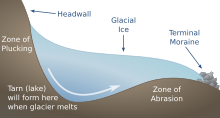Proglacial lake

In geology, a proglacial lake is a lake formed either by the damming action of a
Moraine-dammed


The receding glaciers of the tropical
Several proglacial lakes have also formed in recent decades at the end of glaciers on the eastern side of
On a smaller scale, a mountain glacier may excavate a depression forming a cirque, which may contain a mountain lake, called a tarn, upon the melting of the glacial ice.[2]
Ice-dammed

The
A similar event takes place after irregular periods in the
About 13,000 years ago in North America, the
In some cases, such lakes gradually evaporated during the warming period after the
The following table is a partial list of rivers that had glacial ice dams.
| Flood/River[7] | Location | Date | Peak discharge (106 m3/s) | Reference |
|---|---|---|---|---|
| Kuray | Altai, Russia | Late Pleistocene | 18 | Baker et al., 1993 |
Missoula
|
Northwestern US | Late Pleistocene | 17 | O'Connor and Baker, 1992 |
| Darkhat Lakes | Mongolia | Late Pleistocene | 4 | Rudoy, 1998 |
| Jassater Lakes | Altai, Russia | Late Pleistocene | 2 | Rudoy, 1998 |
| Yaloman Lakes | Altai, Russia | Late Pleistocene | 2 | Rudoy, 1998 |
| Ulymon Lakes | Altai, Russia | Late Pleistocene | 1.9 | Rudoy, 1998 |
| Lake Regina | Canada/US | Late Pleistocene | 0.8 | Lord and Kehew, 1987 |
| Wabash River | Indiana, US | Late Pleistocene | 0.27 | Vaughn and Ash, 1983 |
| Lake Agassiz | US
|
Late Pleistocene | 0.13 | Matsch, 1983 |
| Porcupine River | Alaska, US | Late Pleistocene | 0.13 | Thorson, 1989 |
| Russell Fiord | Alaska, US | 1986 | 0.10 | Mayo, 1989 |
Retreating ice sheet

The retreating glaciers of the last ice age, both depressed the terrain with their mass and provided a source of meltwater that was confined against the ice mass. Lake Algonquin is an example of a proglacial lake that existed in east-central North America at the time of the last ice age. Parts of the former lake are now Lake Huron, Georgian Bay, Lake Superior, Lake Michigan and inland portions of northern Michigan.[1] Examples in Great Britain include Lake Lapworth, Lake Harrison and Lake Pickering. Ironbridge Gorge in Shropshire and Hubbard's Hills in Lincolnshire are examples of a glacial overspill channel created when the water of a proglacial lake rose high enough to breach the lowest point in the containing watershed.
See also
- Ice jam – Accumulation of ice in a river
- List of prehistoric lakes
- Pluvial lake – Landlocked basin (endorheic basin)
- Proglacial lakes of Minnesota
- Lacustrine Plain
References
- ^ a b Asher-Bolinder, Sigrid (1988). U.S. Geological Survey Bulletin. U.S. Government Printing Office.
- ^ "Illustrated Glossary of Alpine Glacial Landforms". Archived from the original on 11 August 2007. Retrieved 5 August 2007.
- ^ ice jam at the Encyclopædia Britannica
- ^ Reeburgh, William S.; Nebert, D. L. (3 August 1987), The Birth and Death of Russell Lake, Alaska Science Forum, archived from the original on 3 May 2012, retrieved 29 March 2018
- ^ Ice Break, The Geological Society, 26 March 2004, archived from the original on 17 December 2005
- ^ http://www.cr.nps.gov/history/online_books/geology/publications/inf/72-2/sec5.htm Archived 13 February 2015 at the Wayback Machine USGS The Channeled Scablands of Eastern Washington
- ^ O'Connor, J.E., and Costa, J.E., 2004, The world's largest floods, past and present—Their causes and magnitudes: U.S. Geological Survey Circular 1254, 13 p.
Bibliography
- Baker, V.R., Benito, G., and Rudoy, A.N., 1993. Paleo-hydrology of late Pleistocene superflooding, Altay Mountains, Siberia: Science, 259, p. 348–350.
- Lord, M.L., and Kehew, A.E., 1987, Sedimentology and paleohydrology of glacial-lake outburst deposits in southeastern Saskatchewan and northwestern North Dakota: Geological Society of America Bulletin v. 99, p. 663–673.
- Matsch, C.L., 1983, River Warren, the southern outlet of Glacial Lake Agassiz, in Teller, J.T., and Lee, Clayton, Glacial Lake Agassiz: Geological Association of Canada Special Paper 26, p. 231–244.
- Mayo, L.R., 1989, Advance of Hubbard Glacier and 1986 outburst of Russell Fiord, Alaska, U.S.A.: Annals of Glaciology, v. 13, p. 189–194.
- O'Connor, J.E., and Baker, V.R., 1992, Magnitudes and implications of peak discharges from Glacial Lake Missoula: Geological Society of America Bulletin, v. 104, p. 267–279.
- Rudoy, A., 1998, Mountain ice-dammed lakes of southern Siberia and their influence on the development and regime of the intracontinental runoff systems of North Asia in the late Pleistocene, in Benito, G., Baker, V.R., and Gregory, K.J., eds., Paleohydrology and Environmental Change: John Wiley and Sons, p. 215–234.
- Thorson, R.M., 1989, Late Quaternary paleofloods along the Porcupine River, Alaska—Implication for regional correlation, in Carter, L.D., Hamilton, T.D., and Galloway, J.P., eds., Late Cenozoic history of the interior basins of Alaska and the Yukon: U.S. Geological Survey Circular 1026, p. 51–54.
- Vaughn, D., and Ash, D.W., 1983, Paleohydrology and geomorphology of selected reaches of the upper Wabash River, Indiana: Geological Society of America Program with Abstracts, v. 15, no. 6, p. 711.

